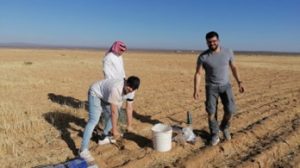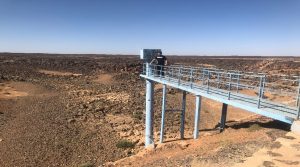
July 18, 2022, by lzzeb
Farming system in the black desert (Harrat Al-Sham): resilience to face climate change
A blog by Ali Ben Mustapha
Farming system in drylands is considered as the most vulnerable system to climate change although several drylands in the world are more productive than wetlands. This is generally dependent on many factors like knowledge, technology, big budgets and natural resources availability like water. Those factors could improve the yield and make it among the best is the world. But these factors could not be able to ensure the resilience and the sustainability of such system where extensive crop production system is adopted. Located in north-eastern part of the Jordanian kingdom, our study area is a small spot (12 km2) in the middle of a large black desert covered by basalt rocks and belong to the fertile crescent. This cultivable spot has been producing crops like barley and wheat for hundreds of years or maybe thousands of years and until nowadays this rainfed farming system still producing these types of crops with an important quantities where local precipitation does not exceed 100mm/year. The secrets behind this are first, the two main wadis (Rajel and Selma) that flow into the Q’a Shubayqa seasonally where floods came from the surrounded hights especially Jabal druz mountain located in Southern Syria. The second secret is the high soil quality with high organic matter content and high-water retention capacity. The third secret is the farming practices adopted by small-holder farmers like free-pesticides and free-fertilisers farming system, low tillage, low sowings rate and mixing copping system with livestock breeding. All these factors, which were confirmed by local farmers during my field works, have improved the capability of the existing farming system to survive the climate change during the past centuries.
My last field work in Jordan in early June 2022 was a completion of two previous field works in this area. The first field work was a preliminary visit in February 2020 to Q’a Shubayqa and the surrounding area like Azraq where I have discovered a totally different farming system that mainly depend on irrigation with a large diversity of cultivated crops like cereals, vegetable, fruits and orchards which could be considered as intensive production system. The second field work was about conducting a survey with local farmers and a questionnaire containing different sections (agricultural practices, observed weather alterations, challenges ..) was prepared for the purpose. This field work was meant to be done in May or June of the same year to collect more data that could help to define the main components of the farming system in Q’a Shubayqa. Unfortunately, this field work was cancelled due to the global pandemic spread and travel restrictions. To solve this issue, we have collaborated with Khaled Al-Masaeed (Ingeneer in the north Badia research centre) to conduct the survey on behalf of me and arrange interviews with participant farmers.
The last field work was a good opportunity for me to gather the missing chain circles about the farming system in Q’a Shubayqa by doing face to face meeting with farmers and researchers from the University of Jordan (Agricultural department) and the National Agricultural Research Centre (NARC) and conducting soil sampling from different sites of the Q’a. It was also a fantastic experience for me by visiting this fantastic area and being hosted by local Bedouin people.
The collected information will allow me to define the farming system components and specificities, challenges and limiting factors and finally to conduct modelling research that could produce potential management strategies to adapt with future climate changes and maintain the resilience of the farming system.
No comments yet, fill out a comment to be the first



Leave a Reply